Chonglin Sun
External Large Foundation Model: How to Efficiently Serve Trillions of Parameters for Online Ads Recommendation
Feb 26, 2025



Abstract:Ads recommendation is a prominent service of online advertising systems and has been actively studied. Recent studies indicate that scaling-up and advanced design of the recommendation model can bring significant performance improvement. However, with a larger model scale, such prior studies have a significantly increasing gap from industry as they often neglect two fundamental challenges in industrial-scale applications. First, training and inference budgets are restricted for the model to be served, exceeding which may incur latency and impair user experience. Second, large-volume data arrive in a streaming mode with data distributions dynamically shifting, as new users/ads join and existing users/ads leave the system. We propose the External Large Foundation Model (ExFM) framework to address the overlooked challenges. Specifically, we develop external distillation and a data augmentation system (DAS) to control the computational cost of training/inference while maintaining high performance. We design the teacher in a way like a foundation model (FM) that can serve multiple students as vertical models (VMs) to amortize its building cost. We propose Auxiliary Head and Student Adapter to mitigate the data distribution gap between FM and VMs caused by the streaming data issue. Comprehensive experiments on internal industrial-scale applications and public datasets demonstrate significant performance gain by ExFM.
Hierarchical Structured Neural Network for Retrieval
Aug 13, 2024



Abstract:Embedding Based Retrieval (EBR) is a crucial component of the retrieval stage in (Ads) Recommendation System that utilizes Two Tower or Siamese Networks to learn embeddings for both users and items (ads). It then employs an Approximate Nearest Neighbor Search (ANN) to efficiently retrieve the most relevant ads for a specific user. Despite the recent rise to popularity in the industry, they have a couple of limitations. Firstly, Two Tower model architecture uses a single dot product interaction which despite their efficiency fail to capture the data distribution in practice. Secondly, the centroid representation and cluster assignment, which are components of ANN, occur after the training process has been completed. As a result, they do not take into account the optimization criteria used for retrieval model. In this paper, we present Hierarchical Structured Neural Network (HSNN), a deployed jointly optimized hierarchical clustering and neural network model that can take advantage of sophisticated interactions and model architectures that are more common in the ranking stages while maintaining a sub-linear inference cost. We achieve 6.5% improvement in offline evaluation and also demonstrate 1.22% online gains through A/B experiments. HSNN has been successfully deployed into the Ads Recommendation system and is currently handling major portion of the traffic. The paper shares our experience in developing this system, dealing with challenges like freshness, volatility, cold start recommendations, cluster collapse and lessons deploying the model in a large scale retrieval production system.
High-performance, Distributed Training of Large-scale Deep Learning Recommendation Models
Apr 15, 2021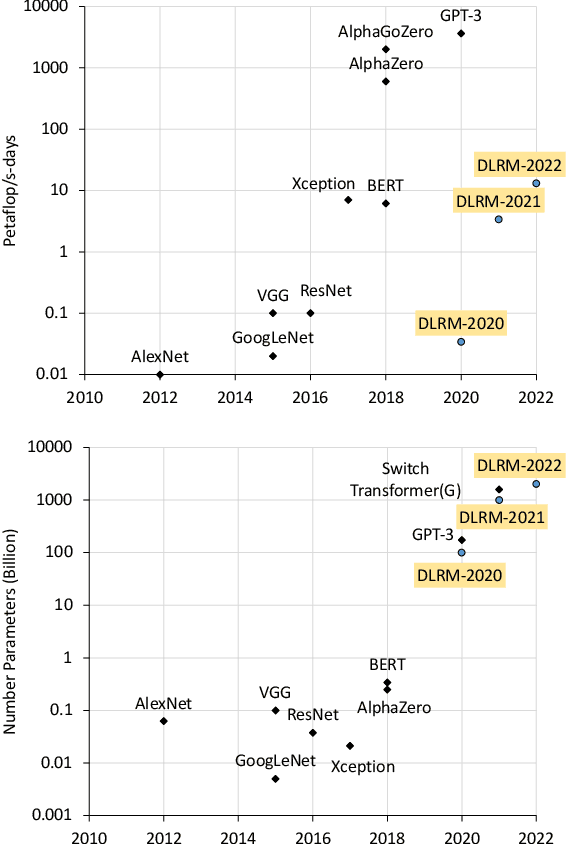
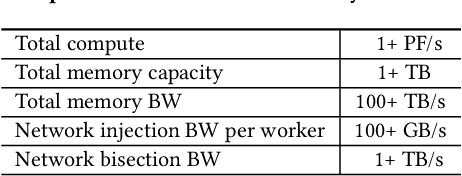
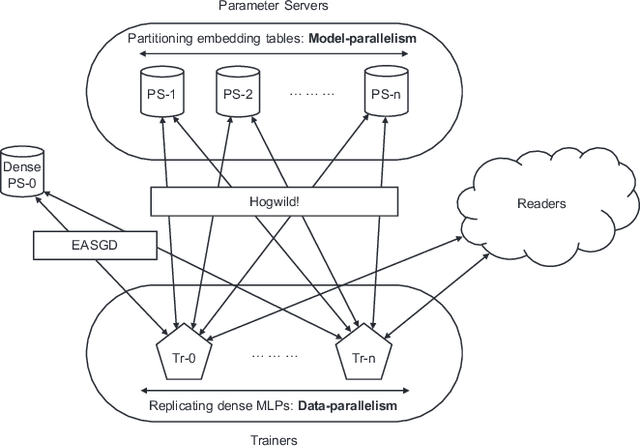
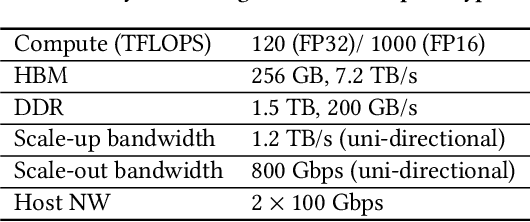
Abstract:Deep learning recommendation models (DLRMs) are used across many business-critical services at Facebook and are the single largest AI application in terms of infrastructure demand in its data-centers. In this paper we discuss the SW/HW co-designed solution for high-performance distributed training of large-scale DLRMs. We introduce a high-performance scalable software stack based on PyTorch and pair it with the new evolution of Zion platform, namely ZionEX. We demonstrate the capability to train very large DLRMs with up to 12 Trillion parameters and show that we can attain 40X speedup in terms of time to solution over previous systems. We achieve this by (i) designing the ZionEX platform with dedicated scale-out network, provisioned with high bandwidth, optimal topology and efficient transport (ii) implementing an optimized PyTorch-based training stack supporting both model and data parallelism (iii) developing sharding algorithms capable of hierarchical partitioning of the embedding tables along row, column dimensions and load balancing them across multiple workers; (iv) adding high-performance core operators while retaining flexibility to support optimizers with fully deterministic updates (v) leveraging reduced precision communications, multi-level memory hierarchy (HBM+DDR+SSD) and pipelining. Furthermore, we develop and briefly comment on distributed data ingestion and other supporting services that are required for the robust and efficient end-to-end training in production environments.
Time-based Sequence Model for Personalization and Recommendation Systems
Aug 27, 2020
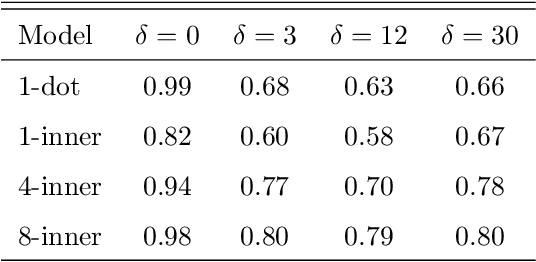
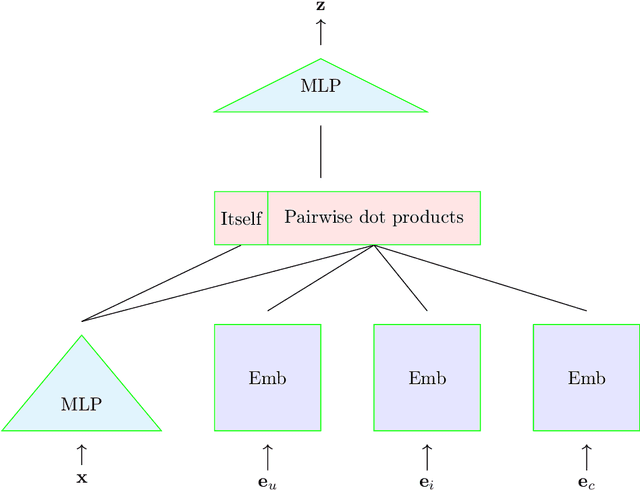
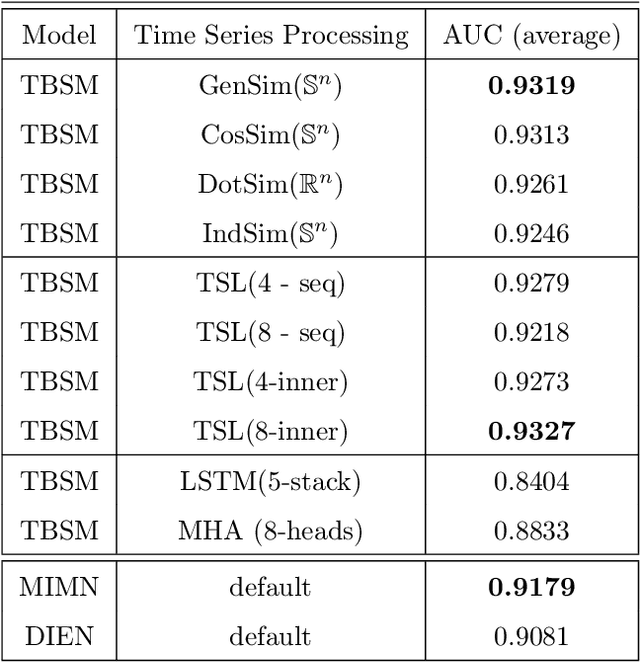
Abstract:In this paper we develop a novel recommendation model that explicitly incorporates time information. The model relies on an embedding layer and TSL attention-like mechanism with inner products in different vector spaces, that can be thought of as a modification of multi-headed attention. This mechanism allows the model to efficiently treat sequences of user behavior of different length. We study the properties of our state-of-the-art model on statistically designed data set. Also, we show that it outperforms more complex models with longer sequence length on the Taobao User Behavior dataset.
Category Enhanced Word Embedding
Nov 30, 2015



Abstract:Distributed word representations have been demonstrated to be effective in capturing semantic and syntactic regularities. Unsupervised representation learning from large unlabeled corpora can learn similar representations for those words that present similar co-occurrence statistics. Besides local occurrence statistics, global topical information is also important knowledge that may help discriminate a word from another. In this paper, we incorporate category information of documents in the learning of word representations and to learn the proposed models in a document-wise manner. Our models outperform several state-of-the-art models in word analogy and word similarity tasks. Moreover, we evaluate the learned word vectors on sentiment analysis and text classification tasks, which shows the superiority of our learned word vectors. We also learn high-quality category embeddings that reflect topical meanings.
A C-LSTM Neural Network for Text Classification
Nov 30, 2015



Abstract:Neural network models have been demonstrated to be capable of achieving remarkable performance in sentence and document modeling. Convolutional neural network (CNN) and recurrent neural network (RNN) are two mainstream architectures for such modeling tasks, which adopt totally different ways of understanding natural languages. In this work, we combine the strengths of both architectures and propose a novel and unified model called C-LSTM for sentence representation and text classification. C-LSTM utilizes CNN to extract a sequence of higher-level phrase representations, and are fed into a long short-term memory recurrent neural network (LSTM) to obtain the sentence representation. C-LSTM is able to capture both local features of phrases as well as global and temporal sentence semantics. We evaluate the proposed architecture on sentiment classification and question classification tasks. The experimental results show that the C-LSTM outperforms both CNN and LSTM and can achieve excellent performance on these tasks.
 Add to Chrome
Add to Chrome Add to Firefox
Add to Firefox Add to Edge
Add to Edge